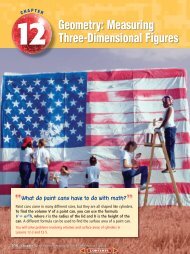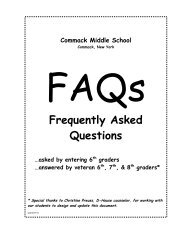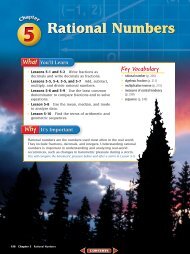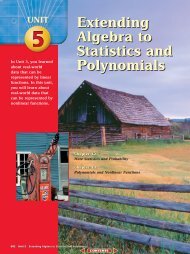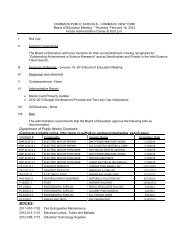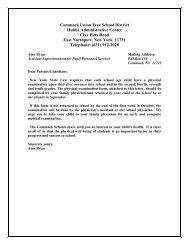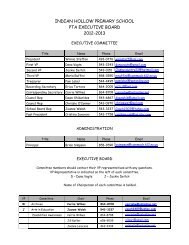Preparing for the Regents Examination Geometry, AK
Preparing for the Regents Examination Geometry, AK
Preparing for the Regents Examination Geometry, AK
Create successful ePaper yourself
Turn your PDF publications into a flip-book with our unique Google optimized e-Paper software.
5 BIG is isosceles because it has two congruent<br />
sides, BI IG √ 50 ; and BIG is<br />
a right triangle because −−<br />
BI is perpendicular<br />
to −−<br />
IG .<br />
6 Two sides ( −−−<br />
QR and −−<br />
PS ) have <strong>the</strong> same slope<br />
of 2 _ and <strong>the</strong> o<strong>the</strong>r two sides (<br />
3 −−<br />
OP and −−<br />
RS )<br />
have <strong>the</strong> same slope of 3. PQRS is a<br />
parallelogram.<br />
7 SAND is a parallelogram because <strong>the</strong> diagonals<br />
bisect each o<strong>the</strong>r at <strong>the</strong> point (1.5, 0.5).<br />
8 LEAP is a parallelogram because all of <strong>the</strong><br />
sides measure √ 50 and are congruent.<br />
9 ABCD is a parallelogram because <strong>the</strong> diagonals<br />
bisect each o<strong>the</strong>r at <strong>the</strong> point (2.5, 0.5).<br />
10 a 6 √ 5 and 2 √ 13<br />
b The diagonals meet at <strong>the</strong>ir midpoint<br />
(1, 1).<br />
c BETH is a parallelogram because <strong>the</strong><br />
diagonals bisect each o<strong>the</strong>r.<br />
d BETH is not a rectangle because <strong>the</strong><br />
diagonals are not congruent.<br />
11 a NICK is a parallelogram; both pairs of<br />
opposite sides are parallel.<br />
b NICK is not a rhombus; <strong>the</strong> diagonals are<br />
not perpendicular.<br />
12 The figure KATE is a square. KATE is a rectangle<br />
because <strong>the</strong> diagonals bisect each o<strong>the</strong>r<br />
and are <strong>the</strong> same length. KATE is a square<br />
because two adjacent sides are congruent.<br />
13 ABCD is a rhombus. ABCD is a parallelogram<br />
because <strong>the</strong> diagonals bisect each o<strong>the</strong>r.<br />
ABCD is a rhombus because two adjacent<br />
sides are congruent.<br />
14 a Slopes of −−<br />
SU and −−<br />
UE are negative reciprocals<br />
proving <strong>the</strong>se two lines <strong>for</strong>m a right<br />
angle by being perpendicular; <strong>the</strong>re<strong>for</strong>e,<br />
SUE is a right triangle.<br />
b SU 5 and UE 10<br />
15 a NORA is a parallelogram because <strong>the</strong><br />
diagonals bisect each o<strong>the</strong>r. NORA is a<br />
rhombus because two adjacent sides are<br />
congruent.<br />
b NORA is not a square because it does not<br />
contain a right angle.<br />
42 Chapter 8: Slopes and Equations of Lines<br />
16 a JACK is a trapezoid because it has only<br />
one pair of opposite sides parallel;<br />
slope of −−<br />
JA slope of −−<br />
CR 1.<br />
b JACK is not an isosceles trapezoid because<br />
<strong>the</strong> legs are not congruent.<br />
17 MARY is a trapezoid because it has only<br />
one pair of opposite sides parallel; slope of<br />
−−−<br />
MA slope of −−<br />
RY 0. MARY is an isosceles<br />
trapezoid because <strong>the</strong> legs are congruent;<br />
AR YM 5.<br />
18 C(a, 0)<br />
19 P(b a, c)<br />
20 E(a, 0), F(a, 2a), G(a, 2a)<br />
21 C(a, b r)<br />
22 M(a c, b)<br />
23 T(a, 2a)<br />
24 R(a b, c)<br />
25 Yes<br />
26 Slope of −−<br />
AC is 1 and <strong>the</strong> slope of −−<br />
BD is 1.<br />
Since <strong>the</strong> slopes are negative reciprocals,<br />
−−<br />
AC −−<br />
BD .<br />
27 a Midpoint of −−<br />
BC is (a, b).<br />
28 a<br />
b MA MB MC √ a 2 b 2<br />
T(0, 0)<br />
y<br />
E(2x, 2y)<br />
Q(4x, 0)<br />
x<br />
b A(x, y), B(3x, y), C(2x, 0)<br />
c The length of median −−<br />
TB is √ 9 x 2 y 2 .<br />
The length of median −−<br />
EC is 2y. The length<br />
of median −−−<br />
QA is √ 9 x 2 y 2 .<br />
d TEQ is an isosceles triangle.<br />
29 TA TR √ <br />
( c _<br />
2 ) 2<br />
d 2<br />
30 −−<br />
JA and −−<br />
NE are parallel to <strong>the</strong> x-axis and<br />
each slope is 0; thus <strong>the</strong>y are parallel to each<br />
o<strong>the</strong>r. Slope of −−−<br />
AN slope of −−<br />
EJ c _ ; thus<br />
b<br />
<strong>the</strong>y are parallel. There<strong>for</strong>e, JANE is a<br />
parallelogram.<br />
31 Midpoint of −−<br />
AC midpoint of<br />
−−<br />
BD <br />
a r ( _ ,<br />
s<br />
2 _<br />
2 )<br />
32 TA EM √ <br />
(a b) 2 c 2








